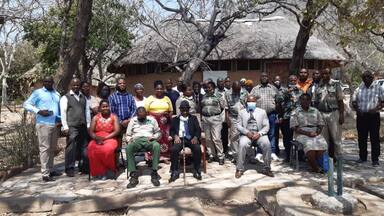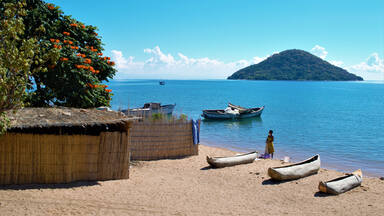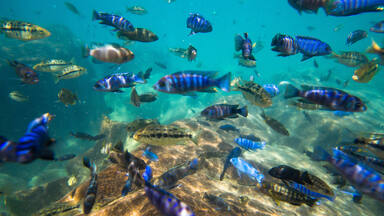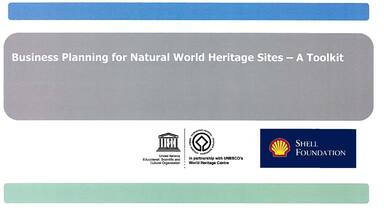Lake Malawi National Park
Lake Malawi National Park
Located at the southern end of the great expanse of Lake Malawi, with its deep, clear waters and mountain backdrop, the national park is home to many hundreds of fish species, nearly all endemic. Its importance for the study of evolution is comparable to that of the finches of the Galapagos Islands.
Description is available under license CC-BY-SA IGO 3.0
Parc national du lac Malawi
Situé au sud de l'immense lac Malawi, aux eaux claires et profondes et à l'arrière-plan de montagnes, le parc abrite plusieurs centaines d'espèces de poissons, presque toutes endémiques, qui présentent pour la théorie de l'évolution un intérêt comparable à celui des pinsons des îles Galapagos.
Description is available under license CC-BY-SA IGO 3.0
الروضة الوطنيّة على نهر ملاوي
تقع الروضة في جنوب نهر الملاوي الكبير الذي يتّسم بالمياه الصافية والعميقة والذي تحدّه الجبال. وتأوي المئات من أنواع السمك وكلها تقريبًا مستوطنة، ما يعطيها أهميّة لدراسة التّطور توازي أهميّة طيور البرقش في جزر غالاباغوس.
source: UNESCO/CPE
Description is available under license CC-BY-SA IGO 3.0
马拉维湖国家公园
马拉维湖国家公园位于宽阔的马拉维湖最南端,湖水清澈深邃,背后群山相伴。马拉维湖国家公园保护着上百种当地的特有鱼类,其对于进化研究的重要性可与厄瓜多尔西部的加拉帕哥斯群岛上的雀类相提并论。
source: UNESCO/CPE
Description is available under license CC-BY-SA IGO 3.0
Национальный парк Озеро Малави
Парк расположен на южной оконечности огромного озера Малави (Ньяса), окруженного горами и характеризующегося большими глубинами и чистой водой. Здесь обитают сотни видов рыб, и практически все они эндемичны. Уникальная ихтиофауна озера Малави (так же как и вьюрки Галапагосских островов) имеет большое значение с точки зрения изучения эволюции жизни на Земле.
source: UNESCO/CPE
Description is available under license CC-BY-SA IGO 3.0
Parque Nacional del Lago Malawi
Situado en un paisaje con trasfondo de montañas, este parque abarca el extremo sur del vasto lago Malawi, que alberga en sus aguas claras y profundas centenares de especies de peces, casi todas endémicas, cuyo interés para la teoría de la evolución es comparable al de los pinzones de las Islas Galápagos.
source: UNESCO/CPE
Description is available under license CC-BY-SA IGO 3.0
マラウイ湖国立公園
source: NFUAJ
Nationaal park Malawi meer
Het Nationaal park Malawi meer ligt aan de zuidkant van het grote uitspansel van het meer van Malawi, met zijn diepe, heldere water en bergen op de achtergrond. Het nationale park is de thuisbasis van honderden vissoorten, bijna allemaal inheems. Het belang van deze vissen voor de bestudering van de evolutie is vergelijkbaar met de belangrijke rol van vinken op de Galápagos Eilanden. Het park is 94,1 vierkante kilometer groot, waarvan 7 vierkante kilometer bestaat uit wateroppervlak. Dit is voldoende om de waterpartijen en processen te beschermen die van belang zijn voor het behoud van de rijke biodiversiteit van het meer.
Source: unesco.nl
Outstanding Universal Value
Brief synthesis
Located at the southern end of the great expanse of Lake Malawi, the property is of global importance for biodiversity conservation due particularly to its fish diversity. Lying within the Western Rift Valley, Lake Malawi is one of the deepest lakes in the world. The property is an area of exceptional natural beauty with the rugged landscapes around it contrasting with the remarkably clear waters of the lake. The property is home to many hundreds of cichlid fish, nearly all of which are endemic to Lake Malawi, and are known locally as "mbuna". The mbuna fishes display a significant example of biological evolution. Due to the isolation of Lake Malawi from other water bodies, its fish have developed impressive adaptive radiation and speciation, and are an outstanding example of the ecological processes.
Criterion (vii): The property is an area of exceptional natural beauty with its islands and clear waters set against the background of the Great African Rift Valley escarpment. Habitat types vary from rocky shorelines to sandy beaches and from wooded hillsides to swamps and lagoons. Granitic hills rise steeply from lakeshore and there are a number of sandy bays.
Criterion (ix): The property is an outstanding example of biological evolution. Adaptive radiation and speciation are particularly noteworthy in the small brightly coloured rocky-shore tilapiine cichlids (rockfish), known locally as mbuna. All but five of over 350 species of mbuna are endemic to Lake Malawi and represented in the park. Lake Malawi's cichlids are considered of equal value to science as the finches of the Galapagos Islands remarked on by Charles Darwin or the honeycreepers of Hawaii.
Criterion (x): Lake Malawi is globally important for biodiversity conservation due to its outstanding diversity of its fresh water fishes. The property is considered to be a separate bio-geographical province with estimates of up to c.1000 species of fish half occurring within the property: estimated as the largest number of fish species of any lake in the world. Endemism is very high: of particular significance are the cichlid fish, of which all but 5 of over 350 species are endemic. The lake contains 30% of all known cichlids species in the world. The property is also rich in other fauna including mammals, birds and reptiles.
Integrity
The property is sufficiently large (94.1 km2 of which 7km2 is aquatic zone) to adequately represent the water features and processes that are of importance for long term conservation of the lake's rich biodiversity and exceptional natural beauty. The water area within the national park protects the most important elements of the lake's biodiversity. It also protects all major underwater vegetation types and important breeding sites for the cichlids. Many other fish species of Lake Malawi are however unprotected due to the limited size of the park in relation to the overall area of the lake. Thus, at the time of inscription the World Heritage Committee recommended that the area of the national park be extended. The property's long term integrity largely depends on the overall conservation and management of the lake which falls under the jurisdiction of three sovereign states i.e. Malawi, Tanzania and Mozambique.
Protection and management requirements
Lake Malawi National Park is protected under national legislation and the resources of the park are managed and controlled by the Department of National Parks and Wildlife.
The park has a management plan and, there is also a strategic tourism management plan for Malawi which describes the tourism development for the site. Utilisation of park resources is restricted to curb the illegal harvesting of resources. There are five villages included within enclaves inside the property. The local population is dependent on fishing for a livelihood as the soil is poor and crop failure frequency is high. Whilst the property's terrestrial and underwater habitats are still in good condition, management planning needs to deal more effectively with the threats of rapid growth of human population and the impacts of firewood collection, fish poaching and crowded fish landing sites. Thus a key management priority is the maintenance of the lake ecosystem while taking into consideration the needs of the local community through collaborative management programmes. The implementation of the Wildlife Policy that mandates park management to work in collaboration with local communities within and outside park boundaries and share responsibilities and benefits accruing from the management of the park is important to enable effective management to be implemented. Potential threats from introduced fish species which could displace endemics, pollution from boats and siltation from the denuded hills, need to be minimised and require close monitoring. Collaboration with the governments of Tanzania and Mozambique needs to be maintained and strengthened for the long term protection and management of the entire lake ecosystem, and consideration of the potential for its extension is required.










